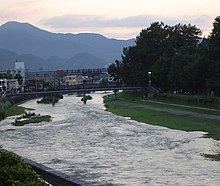Native name 北上川 Length 249 km Basin area 10,150 km² Country Japan | Main source Mt. Nanashiruge Discharge 391 m³/s Mouth elevation 0 | |
 | ||
River mouth Pacific Ocean0 m (0 ft) Basin size 10,150 km (3,920 sq mi) | ||
Tragedy of kitakami river by giant tsunami
The Kitakami River (北上川, Kitakami-gawa) is the fourth largest river in Japan and the largest in the Tōhoku region. It is 249 kilometres (155 mi) long and drains an area of 10,150 square kilometres (3,920 sq mi). It flows through mostly rural areas of Iwate and Miyagi Prefectures. The source of the river is the Mount Nanashiruge in northern Iwate, from which it flows to the south between the Kitakami Mountains and the Ou Mountains. The river is unusual in that it has two mouths, one flowing south into Ishinomaki Bay and the other flowing east into the Pacific Ocean, both in Ishinomaki City.
Contents
Map of Kitakami River, Japan
The Kitakami river was an important transportation route during the Edo period and before the building of railways in the early Meiji period. Numerous dams have been constructed on the river and its tributaries from the Taisho and Showa periods for hyroelectric power generation, flood control and irrigation. However, another unusual feature is that there are no dams from its mouth to the Shijūshida Dam north of Morioka. This allows for a spectacular salmon run every fall.
Tributaries
In Iwate Prefecture from north to south showing from which direction the water flows and the city where it empties into the Kitakami River.
